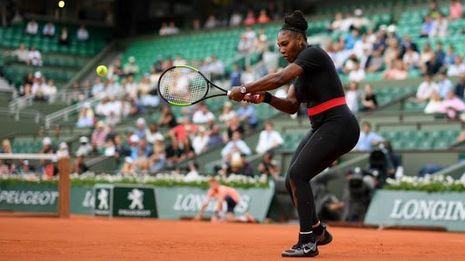The Way We Watch: Sports, Women and the Male Gaze
Co-editor Martha Bevan argues that the act of viewing sport is tainted by narratives that frame and restrict female athletes.

Anyone who has ever watched sports knows that sportswomen are grossly over-sexualised. You don’t need me to tell you that. A quick Google search of “female athletes” will direct you to such riveting content as lists of the “50 Hottest female athletes ever” or the “20 best bums in sports”. Sports photographers often capture voyeuristic images of female athletes that are later even distributed on pornographic websites under imaginative titles such as “Volleyball asses”.
This fine brand of sports journalism is often justified by the commercial logic of “sex sells”. It’s not our fault, sports photographers and journalists argue, we are just providing what the people want. And the people want sex.
"This depiction of women within sports relies on and furthers deep-seated assumptions about women’s place in sport"
Or so they say. This excuse relies on an implicit assumption about who the viewer of sports is: it assumes sport is, and should be, viewed exclusively by straight men. This depiction of women within sports relies on and furthers deep-seated assumptions about women’s place in sport – as players or viewers. It implies that the only way to view sport is through the eyes of the male gaze.
In fact, every aspect of the way in which we view women’s sport is peppered with misogynistic narratives. Women’s value in sport is fundamentally linked to their sexual availability to men, and our perception of female athletes is conditioned by the dynamics of male sexuality.
The most blatant way in which this narrative plays out is the ubiquitous dichotomy between athleticism and appearance. A 2017 poll by BT Sport found that 67% of elite female athletes in the UK felt that they were judged for their appearance, while another study found that 5/6 young women felt disempowered by the idea that sportswomen’s bodies are too masculine.
"... sport creates a narrative that defines women’s bodies by patriarchal categories"
This narrative presents young women with the need to choose between a body that functions and a body that can be objectified. Rather than being a space of bodily autonomy and self-definition, sport creates a narrative that defines women’s bodies by patriarchal categories.
And this is not to say that men are not subject to similar scrutiny – I have had the pleasure of reading Buzzfeed articles during the Olympics before. However, while male athletes are similarly objectified, this objectification does not fundamentally oppose their athletic ability.
Interestingly, this dichotomy between the weak feminine and the strong masculine is at the heart of sports. For some bizarre reason, we have decided that some sports are suited to women, and others to men. Sports such as gymnastics, in which aesthetically-pleasing motions emphasise the erotic gracefulness of the female body, are deemed “gender-appropriate”. Women’s place in these sports is more accepted than in sports such as rugby or boxing, which emphasise strength and aggression.
If this wasn’t enough to reinforce gender binaries, sports such as figure skating underline the heterosexual assumptions of the way we view sport. Many sociologists have compared the routines to mating rituals, and argue that these erotic undertones are central to the sport’s very meaning.
We could stop here. Ok, we don’t just sexualise female athletes; we view them through all manner of sexist and heteronormative narratives. It’s not good. Capiche. But what about those who don’t fit into these narratives? If sport enforces ideas about gender and sexual normativity, what about those who transgress?
Well, the easy answer is that sport punishes those who transgress. In this act of framing and defining femininity, there is an implicit judgement and marginalisation of those who defy sport’s narratives.
We police the appearance of women in sports. The release of Nike Pro’s Hijab prompted outrage – after all, why should women be allowed to decide what they wear to compete? Especially not if you can run whole marathons, like Manal A Rostrom.
Perhaps the most blood-boiling instance of this occurred at the 2018 edition of the French Open. Serena Williams, arguably one of the most successful sportswomen of all time, was issued with a warning for not having shown “respect to the game”. Her crime? Donning a catsuit that was designed to reduce her risk of blood clots after a tough pregnancy.
The backlash that Williams has faced throughout her career is testimony to the way in which femininity is policed. Her and her sister Venus have been referred to as the “Williams brothers” for their muscled physique, and in 2018 she was fined $17,000 for an altercation with an umpire.
Throughout her career, she has been demeaned for her “unfeminine” physicality, and has been boxed into the trope of the “angry black woman”. Serena doesn’t, and won’t conform to the western notions of femininity that govern sports. This is why she has often been marginalised by the media and society.
In fact, her race plays a central role in this narrative. The male gaze through which we view sport is a specifically western one, and the femininity that is defined by it is of the same nature. Women of colour are frequently othered, and their very identity is policed – whether it’s what clothes they choose to compete in or indeed their very gender.
Nowhere is this more clear than in the case of Caster Semenya, the 800m runner: you cannot write an article about the gendering of sport without mentioning her name. However, she’s just the latest in a long series of women of colour marginalised by the politics of sex testing.
It is interesting that back in 2016-8, when she was competing, there were two other women of colour whose gender was also called into question. Similar comments were made about Francine Niyonsaba of Burundi and Margaret Wambui of Kenya, however, unlike Semenya, there was no evidence of either of them having higher testosterone levels at the time.
Their gender was called into question as a result of visual observations, observations that were tainted by ideas about what a woman should look like. The viewer’s eye, and the western ideas of femininity that informed it, seemed enough to define their gender.
As a matter of fact, sex testing in itself is a perfect illustration of the power of misogynistic narratives within sport. Its supporters claim that they are “protecting real women”, thus implying that they can determine the limits of femininity, and that athletes such as Semenya are not women. It creates an “other”, allowing what is in reality a messy category to be neatly defined.
And most importantly, it creates a false binary between femininity and athletic excellence. Nobody questions the physical anomalies of Michael Phelps or Usain Bolt. Their nature as “outliers” does not come into conflict with their masculinity; they are complementary. But for women, any sign of extraordinary athletic ability, whether it’s Serena or Caster, is a question mark over their gender.
So there we have it. This sexualisation of women in sports runs far deeper than the claim that “sex sells”. The marginalisation of female athletes is not just a product of what happens on the playing field; it is also linked to how we watch sports.
The entire way in which we view sports is founded upon racist and misogynistic narratives that not only limit women’s place in sports but claim authority over women and their identity. Our very act of viewing is an act of defining, judging and punishing.
The way we watch sports is a westernised, heterosexual, male one. And until we learn to view sport differently, the position of female athletes will be difficult to elevate.
 News / Cambridge academics stand out in King’s 2026 Honours List2 January 2026
News / Cambridge academics stand out in King’s 2026 Honours List2 January 2026 Interviews / You don’t need to peak at Cambridge, says Robin Harding31 December 2025
Interviews / You don’t need to peak at Cambridge, says Robin Harding31 December 2025 Comment / What happened to men at Cambridge?31 December 2025
Comment / What happened to men at Cambridge?31 December 2025 News / Varsity’s biggest stories of 202531 December 2025
News / Varsity’s biggest stories of 202531 December 2025 Features / “It’s a momentary expression of rage”: reforming democracy from Cambridge4 January 2026
Features / “It’s a momentary expression of rage”: reforming democracy from Cambridge4 January 2026










